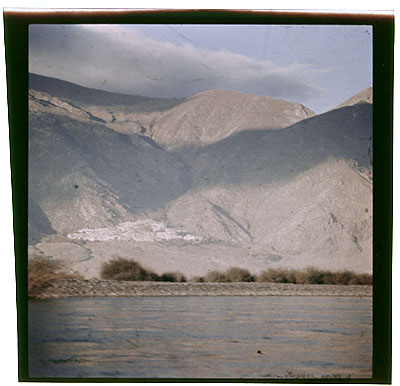
2001.59.8.74.1 (Transparency)


2001.59.8.74.1 (Transparency)

Hugh E. Richardson
Hugh Richardson
1936-50
Lhasa Area > Drepung
2001.59.8.74.1
55 x 57 mm
Transparency Colour
Donated August 2001
The executors of the estate of Hugh E. Richardson
Hugh E. Richardson
Manual Catalogues - Notes on negative album '8' - 'Potala. Colour misc.' [on front cover] [KC 9/9/2006]
Manual Catalogues - Notes on negative index '8' - Folio 74. 'Drepung' c' [KC 13/9/2006]
Clare Harris 2003: Drepung was founded in 1416 by Jamyang Choje Tashi Palden (1397-1449) and named after the abode of Shridhanyakata in south India. It was the largest monastery in the world, inhabited by approximately 9000 monks of the Geluk sect, and was closely associated with the Dalai Lama lineage.
Other Information - Background: Drepung was founded in 1416 by the followers of Tsingkhapa who had already established the Jokhang and instituted the annual New Year ceremony of the 'Great Prayer' or Monlam chenmo (smon lam chen mo) in 1408. In 1409, he founded his own monastery of Ganden (dga ldan) and his style of religion later became known as the Gelugpa (dge lugs pa order closely associated with the Dalai Lama. A further monastery, Sera, was founded in 1419. Since the mid-eighteenth century the Gelugpa ordeer was in control of the government and the administration of the whole of Tibet. The centre of its power was Lhasa where it was overshadowed by the three monasteries of Ganden, Sera and Drepung. In the twentieth century Drepung was the largest monastery with at least 8000 monks and together these monasteries housed more than 20,000 monks. A Cultural History of Tibet , David Snellgrove and Hugh Richardson, 2003, Bangkok: Orchid Press, pp. 180-182, 237. [KC 13/9/2006]
For Citation use:
The Tibet Album.
"Drepung monastery with Kyichu river in foreground"
05 Dec. 2006. The Pitt Rivers Museum.
<http://tibet.prm.ox.ac.uk/photo_2001.59.8.74.1.html>.
For more information about photographic usage or to order prints, please visit the The Pitt Rivers Museum.
© The Pitt Rivers Museum